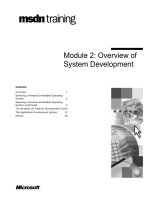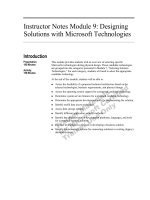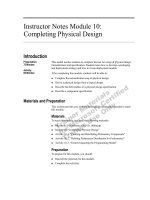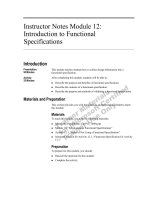Instructor notes module 2 solution design processes
Bạn đang xem bản rút gọn của tài liệu. Xem và tải ngay bản đầy đủ của tài liệu tại đây (80.66 KB, 2 trang )
Instructor Notes Module 2: Solution
Design Processes
Introduction
Presentation:
20 Minutes
Activity:
25 Minutes
This module provides students with a high-level overview of the Microsoft®
Solutions Framework (MSF) Design Process Model and the MSF Application
Model. Students will learn about design processes, how these processes form a
model for solution design, and how they interact with one another. They will
then learn about the various types of services and how these services fit together
to form an application.
After completing this module, students will be able to:
!
Explain design processes as they pertain to a business solution and datacentric solutions.
!
Explain the concepts and benefits of services-based design.
!
Identify phases in the project life cycle.
Materials and Preparation
This section provides you with the materials and preparation needed to teach
this module.
Materials
To teach this module, you will need the following materials:
!
Microsoft PowerPoint® file P02_1609a.ppt
!
Module 2, “Solution Design Processes”
!
Activity 2.1, “Identifying Services”
Preparation
To prepare for this module, you should:
!
Read all materials for this module.
!
Complete the activities.
!
Read the white papers about MSF on the Instructor CD.
2
Instructor Notes Module 2: Solution Design Processes
Activities
Activity 2.1: Identifying Services
In this individual activity, students categorize a list of services as user, business,
or data. They then provide short answers to a series of questions concerning the
use of services in application design. Finally, lead students in a class discussion
of their answers.
Some activities in this course are fairly open-ended in design, but the
assignment of services to layers is a right-or-wrong activity. Ask for volunteers
to share how they assigned the services, rather than calling upon students and
making them reveal an incorrect answer. Then use the responses of the rest of
the class to gauge how well the class has grasped the concepts presented in the
module. If a number of students either answered incorrectly or were puzzled by
the correct answers, you might need to cover the concepts again, using different
examples that you have prepared ahead of time.
After completing this activity, students will be able to:
!
Categorize services as user, business, or data services.
! To prepare for the activity
1. Complete the activity yourself. Be sure you understand to which layer each
service should be assigned and why.
2. Prepare a discussion of the short-answer questions. Be sure you have
examples to start a discussion of the benefits of services-based design.
Module Strategy
Use the following strategy to present this module:
!
Design Processes
This section provides an overview of the MSF Design Process and how it
fits into the overall MSF Process Model. This section then discusses the
three design phases—conceptual, logical, and physical—and discusses how
data is used and modeled within each phase.
Verify that students clearly understand the three phases of the design
process and how the output of one is the input for the next. Also be sure that
students understand the benefits of using all three phases of the design
process.
!
Services-Based Design
In this section, students are introduced to the concept of services and service
layers, with an emphasis on the data services layer. It is critical that students
understand services-based development and the separation of an
application’s parts into cooperating services. It is also critical that students
grasp the difference between the data services layer and the data itself.
Use both the examples in the module and examples of your own to help
students understand the services concept.









